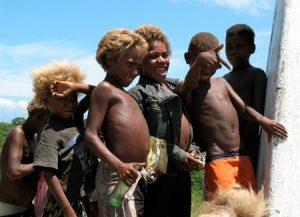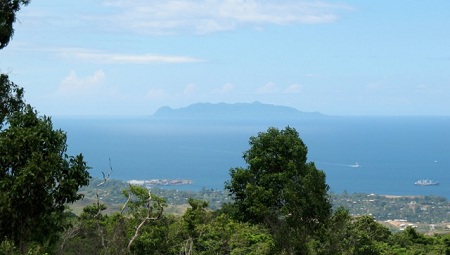In the early morning hours of August 7th, 1942 the armada of the US Navy’s Operation Watchtower Task Force sailed between the southern tip of Savo Island and Cape Esperance into what was then known as Savo Sound. In the dull light of dawn, Navy crewmen and the Marines they were transporting caught site of their target for the first time: Guadalcanal, an island overgrown with tropical plants, steaming jungles, and plantation palm trees. During the following six months, they would wage a brutal campaign against two tireless enemies: the Japanese military and the island’s tropical elements. Over 5,000 US Sailors, 1,769 US Marines, 420 US airmen, and approximately 31,000 Japanese sailors and soldiers were killed during six major naval battles, countless dogfights, and numerous ground offenses. When it was all over, 50 allied and Japanese warships had been destroyed in Savo Sound, giving it its new name of Iron Bottom Sound.
History tells us it was a just campaign that was necessary to protect vital shipping lanes between the United States and Australia. During the early part of 1942, Japan had expanded its sphere of control into the southern and central Pacific, threatening Australia’s national security and the movement of goods by sea. Upon receiving reconnaissance reports of an airstrip being built by the Japanese on the northern coast of Guadalcanal, the Combined Chiefs of Staff headed by Admiral Ernest King made the decision to take the island and the airstrip. Not long after US forces landed on Guadalcanal, the airstrip was secured and renamed Henderson Field in memory of Marine Airman Lofton Henderson, who was killed during the Battle of Midway. Its strategic location between New Caledonia and Bougainville would make Henderson Field invaluable in assisting Allied forces in the march toward Rabaul. Home front news in the United States thrust the obscure island of Guadalcanal into American consciousness as newsreels and newspapers chronicled the battles. In 1942, nearly every American could tell you where the Solomon Islands were located and why they were important as they followed the island hopping news of their fighting sons, brothers, fathers, and uncles.
On Guadalcanal today, there is an American War Memorial, built by American World War II veterans and maintained by the American Battle Monuments Commission. It is located on a hill overlooking Honiara, the capital of the Solomon Islands. Its stark granite slabs are etched with descriptions of the major battles that took place during the campaign. This August 7th, the United States Embassy and the Solomon Island Government will hold a somber anniversary marking 70 years since our diverse cultures converged on the shores of Guadalcanal. American, Australian, New Zealand, Japanese, and Solomon Island dignitaries, military representatives, veterans, and ordinary citizens will assemble at this meticulously kept memorial overlooking Iron Bottom Sound in order to pay tribute to those who served and those who never came home. This anniversary is a unique opportunity to remember and to rebuild the anemic relationship that currently exists between modern day Americans and Solomon Islanders.
Awareness of the Solomon Islands has faded largely due to the attrition of “the greatest generation” who held firsthand knowledge of the United States’ shared history with its people. The Pacific Region, with the exception of the US territories and compact nations, has faded into obscurity with an occasional news story appearing in the New York Times about where the gene for blond hair in Solomon Islanders comes from or reports of marine biodiversity research. Over the past 30 years United States foreign policy in the Pacific has been largely passed on to our friend and ally, Australia. There are many reasons to reconnect with this small independent, democratic island nation again and not solely because of our shared history with them.
Until WWII came to the Pacific, the Solomon Islands was a quiet plantation economy overseen by British colonial rule. The war knocked this tottering economy off its feet and set in motion a number of pivotal changes that have culminated in the Solomon Islands of today. Prior to WWII, the capital of the country was Tulagi in the Florida Islands, but Tulagi was so devastated by war destruction and Honiara’s infrastructure so well built up by the US military occupation it was logical to move the new capital to Guadalcanal. Coastwatcher’s and Solomon Island scouts supplied reconnaissance information to the US military throughout the Guadalcanal Campaign and during the Allied march through the western Solomon Islands. Local men and boys assisted US troops by carrying supplies and by rescuing numerous marooned sailors, downed airmen, and lost soldiers. The most famous rescue was that of President John F. Kennedy when his PT boat was sunk in the Blanche Channel in August 1943. “Bikfala faet” allowed Solomon Islanders to work side by side with US troops, and, in doing so, they developing a level playing field with white men for the first time in their colonial history. This translated into a sense of self-reliance and ultimately led to what is known as Maasina Rura, an emancipation and self-governance movement. In 1978 Solomon Islands gained its independence from Britain. The past 34 years have been a rocky road for the Solomon Islands, which catapulted into independence without a unifying national struggle or shared political ideology that binds its people together.
Civil Unrest
From 1999-2003 the Solomon Islands was challenged by its worst civil unrest since WWII. Guadalcanal based Isatabu Freedom Movement (IFM) forces; some armed with old WWII weapons, waged war against Malaitan Eagle Forces (MEF) over land use and squatters rights. Violence spread throughout the country necessitating the evacuation of expatriates living and working in the islands, including the United States Peace Corp volunteers. Even the main hospital was not spared the civil unrest. Doctors were threatened and militia patients recovering from battle injuries were assassinated in their hospital beds. This period of unrest set the fledgling Solomon Island Government and its public programs back by over 20 years. Early gains in eradicating malaria were lost and the education and healthcare systems suffered significantly outside Honiara. When the Townsville Peace Agreement was signed in 2000 it created a cease-fire between the Malaitan Eagle Forces and the Isatabu Freedom Movement but it failed to resolve the lawlessness. In 2003 Australia’s Prime Minister John Howard authorize military troops be sent into the country to restore order and allow for “nation rebuilding” as a “cooperative intervention.” While there is no evidence to support a direct United States Government role in Australia’s decision to militarily stabilize the Solomon Islands US involvement in Afghanistan post-September 11th and the new world order of addressing terrorism and security clearly influenced the decision.
Today the Regional Assistance Mission to the Solomon Islands (RAMSI), a multi-national police force overseen by the Australian Army has restored stability. With Australia and New Zealand’s assistance Solomon Islands has been rebuilding its government and social services. A gradual RAMSI draw down and transition of policing power to the Solomon Island Royal Police Force has begun. Despite the military intervention known locally as “helpem fren” the Solomon Islands are still at risk of becoming a failed state. Its government and economy remain fragile[1] due to limited economic development and allegations of corruption and nepotism. The current global economic down turn has added to its fragility as Solomon Islands Government operating budget depends on nearly 50% of its funding coming from foreign aid. After the last two elections there were riots and skirmishes amid claims of fraud and election manipulation, clear indicators of the tentative nature of the government’s stability. While Solomon Islanders forge a path of self-leadership it is clear there is a need for appropriate guidance and support to do so. The political climate will likely remain volatile due to the cultural complexity of the Solomon Islands people themselves. Numerous communities or “wantok” systems have made the development of one national voice or mission a difficult task. Solomon Island leaders have fostered unity through conferences addressing events leading to the recent civil unrest. The Solomon Islands Ministry of National Unity, Peace and Reconciliation with contributions by Archbishop Desmond Tutu and other prominent local church leaders has allowed those who were victims of the civil unrest to testify to the human rights abuses, killings, abductions and displacements that left an indelible mark on the country. This process is ongoing today and has helped the country begin to heal and move forward.
The Economy
The Solomon Islands have a long-standing history of receiving external aid. The Solomon Island State has always shared control of its society with other entities such as churches, NGOs and traditional bilateral and multilateral aid agencies. Some see it as perpetuating “cargo cultism” and have criticized the ongoing practice of accepting outside assistance wishing to see the country become more self-reliant and autonomous. During the global recession the Solomon Islands were negatively impacted by a drop in logging exports, and a fall in its GDP by 1.2 per cent in 2009. The economy has since recovered, with a growth of around five to six per cent achieved for 2010 and 2011.

Guadalcanal children sell vintage Coke bottles at the Bloody Ridge monument (Photo courtesy of Eileen Natuzzi)
The majority of the population lives in rural settings with limited clean drinking water and no electricity. They support themselves through subsistence farming and fishing. The average GNI per capita is $1030 US. The Solomon Islands economy is built largely upon the islands natural resources: forests, minerals (lead, zinc, nickel gold and bauxite), fisheries, and land. Exploitation of the country’s resources by multinational corporations has resulted in overfishing and deforestation that exceeds sustainable rates. More than 80 per cent of mined or deforested land is ‘customarily’ owned which means potential investors must negotiate with the government, individual land owners, and entire communities before any natural resource development can take place. With 65% of Solomon Islands Government tariffs coming from timber exports these developments are vital to the country’s current economy. External aid dollars contribute heavily to the government’s budget with the majority of development aid coming from Australia, New Zealand, the World Bank, Asia Development Bank, JICA, ROC Taiwan, and the EU. The unemployment rate is difficult to assess in the Solomon Islands largely due to fluidity of populations, urban migration and subsistence living. In 1999, the last time unemployment was reported it was roughly 45%. A recent increase in crime in the capital has been attributed to the large number of unemployed young people living in Honiara and it has created concerns events similar to the 1999 tensions and unrest may recur.







